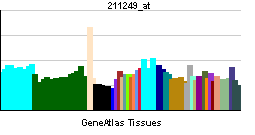GPR68
| G protein-coupled receptor 68 | |||||||||||
|---|---|---|---|---|---|---|---|---|---|---|---|
| Identifiers | |||||||||||
| Symbols | GPR68 ; MGC111379; OGR1 | ||||||||||
| External IDs | Template:OMIM5 Template:MGI HomoloGene: 2603 | ||||||||||
| |||||||||||
| RNA expression pattern | |||||||||||
 | |||||||||||
| More reference expression data | |||||||||||
| Orthologs | |||||||||||
| Template:GNF Ortholog box | |||||||||||
| Species | Human | Mouse | |||||||||
| Entrez | n/a | n/a | |||||||||
| Ensembl | n/a | n/a | |||||||||
| UniProt | n/a | n/a | |||||||||
| RefSeq (mRNA) | n/a | n/a | |||||||||
| RefSeq (protein) | n/a | n/a | |||||||||
| Location (UCSC) | n/a | n/a | |||||||||
| PubMed search | n/a | n/a | |||||||||
G protein-coupled receptor 68, also known as GPR68, is a human gene.[1]
References
Further reading
- Xu Y (2002). "Sphingosylphosphorylcholine and lysophosphatidylcholine: G protein-coupled receptors and receptor-mediated signal transduction". Biochim. Biophys. Acta. 1582 (1–3): 81–8. PMID 12069813.
- An S, Tsai C, Goetzl EJ (1996). "Cloning, sequencing and tissue distribution of two related G protein-coupled receptor candidates expressed prominently in human lung tissue". FEBS Lett. 375 (1–2): 121–4. PMID 7498459.
- Xu Y, Casey G (1996). "Identification of human OGR1, a novel G protein-coupled receptor that maps to chromosome 14". Genomics. 35 (2): 397–402. doi:10.1006/geno.1996.0377. PMID 8661159.
- Bonaldo MF, Lennon G, Soares MB (1997). "Normalization and subtraction: two approaches to facilitate gene discovery". Genome Res. 6 (9): 791–806. PMID 8889548.
- Xu Y, Zhu K, Hong G; et al. (2000). "Sphingosylphosphorylcholine is a ligand for ovarian cancer G-protein-coupled receptor 1". Nat. Cell Biol. 2 (5): 261–7. doi:10.1038/35010529. PMID 10806476.
- Strausberg RL, Feingold EA, Grouse LH; et al. (2003). "Generation and initial analysis of more than 15,000 full-length human and mouse cDNA sequences". Proc. Natl. Acad. Sci. U.S.A. 99 (26): 16899–903. doi:10.1073/pnas.242603899. PMID 12477932.
- Ludwig MG, Vanek M, Guerini D; et al. (2003). "Proton-sensing G-protein-coupled receptors". Nature. 425 (6953): 93–8. doi:10.1038/nature01905. PMID 12955148.
- Bektas M, Barak LS, Jolly PS; et al. (2003). "The G protein-coupled receptor GPR4 suppresses ERK activation in a ligand-independent manner". Biochemistry. 42 (42): 12181–91. doi:10.1021/bi035051y. PMID 14567679.
- Brandenberger R, Wei H, Zhang S; et al. (2005). "Transcriptome characterization elucidates signaling networks that control human ES cell growth and differentiation". Nat. Biotechnol. 22 (6): 707–16. doi:10.1038/nbt971. PMID 15146197.
- Gerhard DS, Wagner L, Feingold EA; et al. (2004). "The status, quality, and expansion of the NIH full-length cDNA project: the Mammalian Gene Collection (MGC)". Genome Res. 14 (10B): 2121–7. doi:10.1101/gr.2596504. PMID 15489334.
- Radu CG, Nijagal A, McLaughlin J; et al. (2005). "Differential proton sensitivity of related G protein-coupled receptors T cell death-associated gene 8 and G2A expressed in immune cells". Proc. Natl. Acad. Sci. U.S.A. 102 (5): 1632–7. doi:10.1073/pnas.0409415102. PMID 15665078.
- Tomura H, Wang JQ, Komachi M; et al. (2005). "Prostaglandin I(2) production and cAMP accumulation in response to acidic extracellular pH through OGR1 in human aortic smooth muscle cells". J. Biol. Chem. 280 (41): 34458–64. doi:10.1074/jbc.M505287200. PMID 16087674.
- Singh LS, Berk M, Oates R; et al. (2007). "Ovarian cancer G protein-coupled receptor 1, a new metastasis suppressor gene in prostate cancer". J. Natl. Cancer Inst. 99 (17): 1313–27. doi:10.1093/jnci/djm107. PMID 17728215.
| Stub icon | This membrane protein–related article is a stub. You can help Wikipedia by expanding it. |